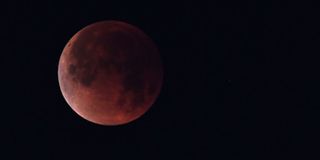Explained: Lunar eclipse, and why the moon appears red

In this file photo taken on January 31, 2018 the "super blue blood moon" is seen over Los Angeles, California.
What you need to know:
- Because the earth will be positioned on a straight line with the sun and the moon, Kenya's exposure to the sun will be contributing to the blocking of sun rays heading to the moon.
- As a result, people in some places on the globe that should be enjoying dazzling moonlight will witness an orange or reddish moon for a number of hours, depending on their location.
The sunshine that Kenyans will be enjoying between 7am and 12pm on Monday will be causing “a red moon” elsewhere in the world.
Because the earth will be positioned on a straight line with the sun and the moon, Kenya's exposure to the sun will be contributing to the blocking of sun rays heading to the moon.
As a result, people in some places on the globe that should be enjoying dazzling moonlight will witness an orange or reddish moon for a number of hours, depending on their location.
In technical terms, this will be a lunar eclipse. In further technical terms, this will be a penumbral lunar eclipse. More on that later.
However, Kenyans will only be causing the eclipse but won’t be able to witness the reddened moon.
Projections show that the next time Kenyans will be able to see a fully red moon in the sky will be in September 2025 when there will be a total lunar eclipse (also called the blood moon).
On September 18 this year, there will be a partial lunar eclipse visible from some parts of Kenya.
Mr Ngetich Benard is a director of studies and a Geography teacher at Kapsabet Boys High School.
He explains that even in areas of the world where the eclipse will be visible, it won’t be the reddest moon ever. This is because of the type of eclipse.
“The penumbral lunar eclipse…occurs when the moon, during the process of orbiting, is positioned within the penumbra. This means it has some faint reddish-orange colour. If you’re not very keen, you may not easily notice,” said Mr Ngetich.
“This phenomenon normally occurs when the sun rays are blocked by the earth and therefore we have the two sections of the shadow. We have the dark part we call the umbra then there is a light part which is called the penumbra,” he added.
“What causes the moon to have the orange-reddish colour is simply because of the sun’s rays as it is passing through the atmosphere. We all understand that the atmosphere has several particles. It has some dust material and the rest. And from the sun, we have what we call the short wavelength rays and the long wavelength ones.
“What will happen is that the shorter wavelength of the sun’s rays are scattered by the atmosphere and therefore it gives it a blue colour on the outer part. But now because the shorter wavelength has been scattered, it means now the longer wavelength is dominant and therefore it tends to appear to have some reddish colour or orange colour, and therefore that is why you see the moon appearing to be orange or reddish in colour,” the teacher further explained.
After every lunar eclipse, a solar eclipse occurs.
This will fall in April where some parts of Canada, Mexico, and the US will experience full darkness during the daytime.
A state like Texas, projections show, will experience 17 minutes of total darkness on April 8.
“We normally experience up to about three lunar eclipses in a year, but we have differences in where they are visible,” explained Mr Ngetich.




